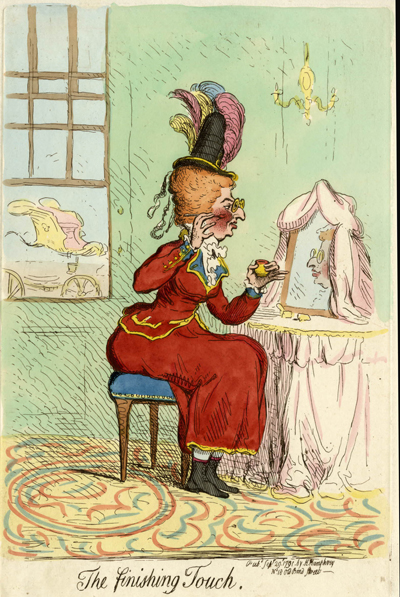The Finishing Touch
The Finishing Touch shows Lady Sarah Archer preparing to take a spin in the high flyer phaeton waiting outside her window. She is dressed in a her preferred scarlet riding outfit with a plumed hat and half boots, and is applying the "finishing touch"—a liberal quantity of rouge.

© Trustees of the British Museum
Because she seemed to have loved being both current and conspicuous, Lady Sarah was one of three society women Gillray could turn to when he needed to produce a satiric caricature on a trending topic. The others were Albinia Hobart (Lady Buckinghamshire), Mrs. Cecilia Johnston, and Lady Mount Edgcumbe. If they did not appear together in a single caricature as in Gillray's La Belle Assemblee 1787), they tended to appear in clusters, as if caricaturing one would suggest a caricature of another. In this case, no less than six caricatures of the women appear within the space of five weeks in September/October 1791.
The satiric object of this particular print is obviously Lady Sarah's excessive use of cosmetics. As a general topic, however, it is one that in the 1790s you couldn't have escaped. First, because, as today, there were constant advertisements for them. A reader of the London World on April 28th, for instance, would have encountered among notices of the current plays, and discussions of Velno's syrup, advertisements like this one from a Mr. Day in Covent Garden, who
begs leave to acquaint the LADIES that he...has just imported a most valuable Package of beautiful Rouge from Paris, such as it held in the highest esteem in all France. Liquid bloom, Carmine, Bloom of Circassia, Pearl Powder, Warren's Milk of Roses... a very fine assortment of the most fragrant foreign pomatums, and the most fashionable coloured Hair Powders.
But in competition with the advertisements for cosmetics, there was also disapproving commentary, warning of both the moral and health risks of "painting." But, like today, mostly in vain. According to the Morning Post and Daily Advertiser April 11, 1791:
Rouge is become common among tradesman's daughters who justify the practice by the custom of their superiors; and accustomed to the rhetoric of novels, they successfully defeat every argument their parents can advance against it.
Sources and Reading
- Commentary from the British Museum on The Finishing Touch
- Lady Sarah Archer, facing the Press, Georgian Gentleman
- Thomas Wright and R.H. Evans, Historical and Descriptive Account of the Caricatures of James Gillray #383
Comments & Corrections
NOTE: Comments and/or corrections are always appreciated. To make that easier, I have included a form below that you can use. I promise never to share any of the info provided without your express permission.